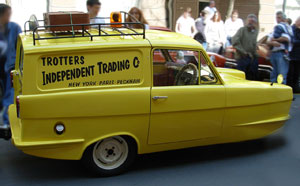 Until well into the twentieth century working class people were either invisible in fiction and drama or else shown as stereotypes: the unworthy and sometimes the worthy poor.
Until well into the twentieth century working class people were either invisible in fiction and drama or else shown as stereotypes: the unworthy and sometimes the worthy poor.
But slowly from the 1950s more positive representations became available, especially as actors, writers and directors from the working class entered the media.
Today we have a mixed picture from, say, Gavin and Stacy to Shameless.
We'd like you to share your thoughts with us and with each other. Here are some questions to ponder:
- What do you think of as s typically working class person?
- What are the dominant images?
- Are they stereotypes?
- Is it impossible to say now?
- When do we see images of working lass people? What are they doing?
Let us know your responses to the statements below, then give us some more of your thoughts, experiences and memories of working class representation in the comments section lower down this page.
Once you've discussed representation, you can visit other discussion hubs about working class work, housing, leisure and struggle. You can also order a free journal of working class life to dig deeper in to each of these issues.
Rate and Review
Rate this activity
Review this activity
Log into OpenLearn to leave reviews and join in the conversation.
Activity reviews
Shameless, Life on Mars, to name but few.
Life on Mars is my favourite TV show ever, in that time, not much was known about social issues but more fun was had.
Shameless seeks to re-educate the so-called chavs and scroungers into a more individualistic outlook. "It's not where yer from, it's where yer at" said Frank Gallagher, now that may work for some... and I did try to adopt that thought process, but it didn't work!
Shameless is not working class, it is underclass. It is the Zoo, scrounging 00's Britain and proud. It represents the majority of people up north under the microscope, the lack of code and conduct instilled in them, the freedom of doing what you want when you want, how you want - have it your way! And be OK with that. You're not responsible for anything! Only YOU matter.
I'm not so sure. Again, I found myself wanting to be from the Chatsworth estate, because there did seem to be a way of learning the potential of the self - even if it was just working in a shop - you knew your place, and you thought for yourself, I never thought for myself, I went where I thought I should go, there was no tribe, no place where I knew the score, I am a nomad. Ah well, can't be helped.
The working classes are truly divided nowadays and encouraged to do what they want for themselves - which encourages crime - sometimes watching Shameless over 10 years you are inclined to think that crime is where the 'buzz' is at. For these people have not the money to enjoy themselves in conventional ways. It's good to be working class, you're more likely to reinvent yourself and be quicker off the mark in an environment such as that. Chatsworth is a pressure cooker and it has fun, I never did, I couldnt say that where I am from is as fun as that. But then I also dont seek for the world to revolve around me. The struggle is hard but I hope to find my place soon. No hedonism for me.
OFAH was brilliant, I would have liked to have been a self-starter like Del boy, but sadly I'm more like Rodney with his GCE in art.
The aspirations of the working classes are muddled, and portrayed so. Comedy is derived from here because you're less likely to be in an ivory tower like with other classes, life is funnier when it's sink or swim, do or die, aimless, directionless, and random.
That is us, constantly divided and conquered. I wish they would stop doing that! Let us be. Let us find our way together, grow together, realise our potential together!
I have a dream.
Adam Tolan - 4 September 2013 5:01am
But slowly from the 1950s more positive representations became available, especially as actors, writers and directors from the working class entered the media.
Really? Well that would explain the writer of OFAH.
Paul O Grady said that this world would be nothing without us working classes, you've no idea how refreshing it is when someone shares your world view, thats whats brought me here today.
I don't think it's as easy to enter the media today from working class areas. This is my experience. But I'm still trying. I'm hungry. No - Really! I haven't eaten since I started writing all this stuff on here, I type so fast when I'm hungry, yeah thats the working classes all over, that. Grr. We taught them how to dance and have sex.
Dinnertime. I'm avvin 'oops.
Any activity by working class groups or individuals generally causes hysteria in the press. This almost always results in a total misrepresentation of the facts or the background of the event.
The most outstanding example was the "tea-break" story from the motor industry in the 1970's.
When employers proposed to reduce a tea break from 20 mins. to 15mins. workers objected, only to be vilified by the popular press.
They ignored the fact that it was physically impossible to get from the line to the canteen and back in the reduced time, and workers were only permitted to eat or drink in the canteen.